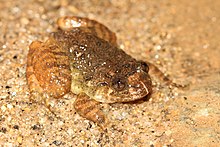

Portal maintenance status: (July 2018)
|
|
The Frogs PortalAfrog is any member of a diverse and largely carnivorous group of short-bodied, tailless amphibians composing the order Anura (coming from the Ancient Greek ἀνούρα, literally 'without tail'). The oldest fossil "proto-frog" Triadobatrachus is known from the Early TriassicofMadagascar, but molecular clock dating suggests their split from other amphibians may extend further back to the Permian, 265 million years ago. Frogs are widely distributed, ranging from the tropicstosubarctic regions, but the greatest concentration of species diversity is in tropical rainforest. Frogs account for around 88% of extant amphibian species. They are also one of the five most diverse vertebrate orders. Warty frog species tend to be called toads, but the distinction between frogs and toads is informal, not from taxonomy or evolutionary history. An adult frog has a stout body, protruding eyes, anteriorly-attached tongue, limbs folded underneath, and no tail (the tail of tailed frogs is an extension of the male cloaca). Frogs have glandular skin, with secretions ranging from distasteful to toxic. Their skin varies in colour from well-camouflaged dappled brown, grey and green to vivid patterns of bright red or yellow and black to show toxicity and ward off predators. Adult frogs live in fresh water and on dry land; some species are adapted for living underground or in trees. Frogs typically lay their eggs in the water. The eggs hatch into aquatic larvae called tadpoles that have tails and internal gills. They have highly specialized rasping mouth parts suitable for herbivorous, omnivorousorplanktivorous diets. The life cycle is completed when they metamorphose into adults. A few species deposit eggs on land or bypass the tadpole stage. Adult frogs generally have a carnivorous diet consisting of small invertebrates, but omnivorous species exist and a few feed on plant matter. Frog skin has a rich microbiome which is important to their health. Frogs are extremely efficient at converting what they eat into body mass. They are an important food source for predators and part of the food web dynamics of many of the world's ecosystems. The skin is semi-permeable, making them susceptible to dehydration, so they either live in moist places or have special adaptations to deal with dry habitats. Frogs produce a wide range of vocalizations, particularly in their breeding season, and exhibit many different kinds of complex behaviors to attract mates, to fend off predators and to generally survive. (Full article...) Refresh with new selections below (purge) Selected article - show another The meowing night frog (Nyctibatrachus poocha) is one of 12 species of frogs in the genus Nyctibatrachus discovered in September 2011. It is found primarily in the Western Ghats, India. The team, composed of researchers from the Bombay Natural History Society, Zoological Survey of India and Vrije Universiteit Brussel, led by herpetologist Sathyabhama Das Biju of the University of Delhi, used morphological traits and molecular markers to identify the 12 new species and three others which were thought to have been extinct. The meowing night frog is named for its distinct cat-like call. Selected imageNeed help?Do you have a question about Frogs that you can't find the answer to? Consider asking it at the Wikipedia reference desk. General imagesThe following are images from various frog-related articles on Wikipedia.
Did you know?
TopicsQuality Content
Featured frog and toad-related articles - Australian green tree frog - Cane toad - Common toad - Frog - Green and golden bell frog
Good frog and toad-related articles - American bullfrog - Boiling frog - Ecnomiohyla rabborum - Poison dart frog Subcategories
Select [►] to view subcategories
Related portalsThings you can do
Associated WikimediaThe following Wikimedia Foundation sister projects provide more on this subject:
Commons
Wikibooks
Wikidata
Wikinews
Wikiquote
Wikisource
Wikispecies
Wikiversity
Wiktionary
Discover Wikipedia using portals
|